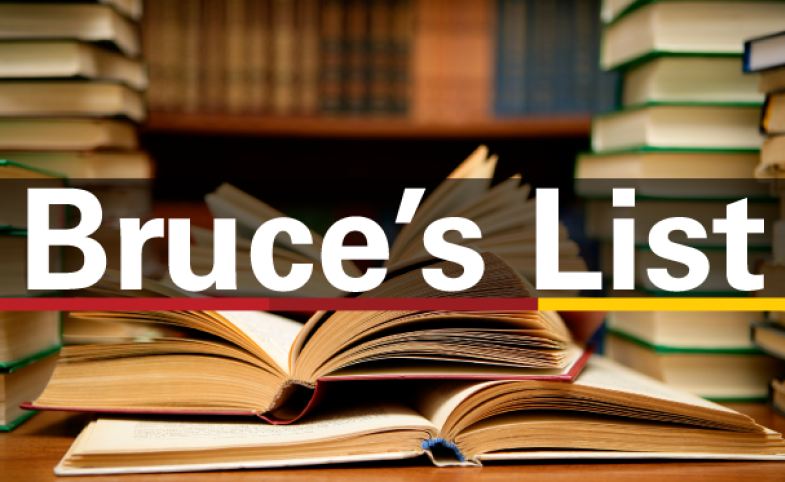The April edition of Bruce Gregory's public diplomacy reading list is now available. Known affectionately at CPD as "Bruce's List," this list is a compilation of books, journal articles, papers and blogs on a wide variety of...
KEEP READING
Fall 2015 Must-Reads in Public Diplomacy
The September 2015 edition of Bruce Gregory's public diplomacy reading list is now available. Known affectionately at CPD as "Bruce's List," this list is a compilation of books, journal articles, papers and blogs on a wide variety of PD topics, and features a number of CPD scholars. Highlights in this edition include:
B. Senem Çevik and Philip Seib, eds., Turkey’s Public Diplomacy, (Palgrave Macmillan, Series in Global Public Diplomacy, 2015). Çevik (University of Ankara) and Seib (University of Southern California) have compiled the first English language study of Turkey’s public diplomacy. Their introductory essay analyzes public diplomacy in the context of Turkey’s rise as a major power in the broader Middle East and in its global reach as a middle power. They examine its contributions to Turkey’s political, economic, military, and cultural initiatives – as well as its limitations and the political and institutional challenges it faces. Chapters by 11 contributors look at historical issues, tools and methods, and how Turkey tailors its public diplomacy in a variety of regional and global relationships.
Andrew F. Cooper, Diplomatic Afterlives, (Polity, 2015). Cooper (University of Waterloo) focuses on an under-studied category of private individuals as governance and diplomatic actors – former world leaders who leverage celebrity and authority derived from their government service to become “policy and norm entrepreneurs” in global networks. Using Jimmy Carter, Bill Clinton, Tony Blair, Mikhail Gorbachev, and Nelson Mandela as case studies, Cooper examines their solutions to global problems and how they seek “to fill gaps and failures” in the state system. He explores the benefits of their innovative model of “extended hybridity,” a combination of insider and outsider roles that connects “not only the closed world of the diplomatic club culture but the diverse worlds of non-state actors.” He also considers the model’s potential deficiencies: lack of accountability, fatigue and shelf life factors, and temptations when public social purpose is blended with a private “dash for cash.”
Brian Hocking and Jan Melissen, Diplomacy in the Digital Age, Clingendael Report, Netherlands Institute of International Relations, July 2015. Clingendael scholars Hocking (Loughborough University) and Melissen (University of Antwerp) provide “initial reflections” on what digitalization means for diplomacy’s forms, processes, and structures. Key questions include: What are the main characteristics of the debate on digital diplomacy? What do we mean by the digital age? How does the broader digitalized environment affect diplomacy? Through a variety of “offline and online perspectives,” they look at changing foreign policy agendas; cyber agendas; knowledge management; digitalization of diplomatic processes and structures in consular work, public diplomacy and international negotiations; and the implications of digitalization for national diplomatic systems and ministries of foreign affairs.
Sinikukka Saari, “Russia’s Post-Orange Revolution Strategies to Increase Its Influence in Former Soviet Republics: Public Diplomacy po russkii,” Europe-Asia Studies, Vol. 66, No. 1, January 2014, 50-66. Saari (Finnish Institute of International Affairs) asserts that public diplomacy has become a more important instrument of Russian foreign policy and that it has two distinctive strands. One, which is directed at Western states, seeks to attract and persuade. A second strand, directed at post-Soviet and Baltic states, is a strategy of manipulation rooted in the Soviet practice of “active measures.” Her article includes a background discussion of public diplomacy concepts and Cold War public diplomacy and then focuses on the implementation of the two strands after the Orange Revolution in Ukraine in 2004. (Courtesy of Yelena Osipova)
“Smart Power,” Public Diplomacy Magazine, USC Center on Public Diplomacy, Summer 2015. PD Magazine takes a fresh look at “smart power,” a term developed by Joseph Nye in 2004 and adopted by former US Secretary of State Hillary Clinton. For Nye, “smart power” is the ability of state and non-state actors to combine “the hard power of coercion and payment with the soft power of persuasion and attraction” in contextually relevant strategies (The Future of Power).
Geoffrey Wiseman, ed., Isolate or Engage: Adversarial States, US Foreign Policy, and Public Diplomacy, (Stanford University Press, 2015). Wiseman (University of Southern California) and the authors of nine case studies examine a central question. What are the challenges and opportunities of US strategies that abstain from or limit formal diplomatic relations with adversarial states, while simultaneously seeking to influence their governments by engaging with their publics? Each case looks at how the US has implemented its isolation and engagement strategies and assesses whether its public diplomacy has been effective. The book is grounded in a carefully constructed methodology and comparative cross-regional framework. The cases illuminate both conceptual frameworks and current policy issues.
To review the entire list, click here.
Visit CPD's Online Library
Explore CPD's vast online database featuring the latest books, articles, speeches and information on international organizations dedicated to public diplomacy.
Popular Blogs
-
January 2
-
December 15
-
December 17
-
November 25
-
December 17










